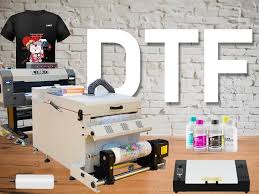Business
DTF Printing: A Comprehensive Tutorial for Beginners

In today’s fast-evolving printing world, entrepreneurs and creative professionals are always searching for flexible, cost-efficient, and high-quality solutions. Among the many technologies available, Direct-to-Film (DTF) printing has emerged as a game-changer, especially for small businesses that want to customize apparel, accessories, and promotional items. For someone just starting their printing journey, learning how DTF printing works can feel overwhelming. That’s why this guide will walk you through the process step by step—covering everything from the basics to advanced tips—while also helping you choose the best DTF printer for small business.
What Is DTF Printing?
DTF printing, or Direct-to-Film printing, is a modern technique that allows you to transfer detailed and colorful designs onto fabrics and other surfaces. Unlike traditional heat transfer vinyl (HTV) or screen printing, DTF eliminates limitations related to fabric type, colors, and design complexity.
The process involves printing a design onto a special film using water-based inks and then applying a powder adhesive. After curing, the design is transferred onto the fabric using a heat press. The results are vibrant, durable, and versatile, making DTF a powerful tool for beginners and professionals alike.
Why Beginners Should Choose DTF Printing:
If you’re new to printing, you might wonder why DTF is such a big deal compared to other methods. Here are a few reasons:
- Cost-Effective Startup: DTF requires less investment compared to screen printing setups.
- Versatility: You can print on cotton, polyester, blends, and even non-fabric items like leather or wood.
- Durability: The prints are long-lasting, with excellent wash resistance.
- No Pretreatment Required: Unlike Direct-to-Garment (DTG) printing, DTF doesn’t need fabric pretreatment.
This combination of affordability and high quality makes DTF ideal for beginners who want to explore printing without the heavy financial burden.
Step-by-Step Tutorial: How DTF Printing Works:
1. Designing the Artwork
Start by creating your design using software like Adobe Illustrator, Photoshop, or CorelDRAW. The design must be print-ready with transparent backgrounds if needed. Beginners should focus on high-resolution artwork to ensure sharp, professional results.
2. Printing on the Film
Load the PET film into your DTF printer and print the design using specialized DTF inks. The printer first lays down white ink, followed by CMYK colors, ensuring the design pops on any fabric color.
3. Applying the Adhesive Powder
While the ink is still wet, apply hot-melt adhesive powder over the design. Shake off the excess to avoid clumps. This powder acts as the bonding agent between the design and the fabric.
4. Curing the Film
Next, cure the powdered film using a curing oven or heat press (without direct pressure). This step melts the adhesive powder, preparing the design for transfer.
5. Heat Press Transfer
Position the film on your garment and press it using a heat press at the recommended temperature and time (usually 160–170°C for 15–20 seconds). Peel off the film after pressing, and your design will remain beautifully embedded in the fabric.
Common Mistakes Beginners Should Avoid:
When learning DTF printing, mistakes are common, but knowing them early can save you time and money:
- Using Low-Quality Film – Cheap films may affect print sharpness and durability.
- Incorrect Powder Application – Too much or too little adhesive leads to poor transfers.
- Ignoring Temperature Settings – Overheating or underheating during transfer can ruin your designs.
- Skipping Test Prints – Always run a test print to check colors and alignment before production.
Choosing the Right Equipment for DTF Printing:
To succeed in DTF printing, having the right equipment is just as important as knowing the process. Key equipment includes:
- DTF Printer – Invest in a reliable machine that balances cost with quality.
- PET Film – Always choose high-grade PET films for consistent results.
- Adhesive Powder – A good-quality adhesive ensures strong, long-lasting transfers.
- Heat Press Machine – Precision and durability depend heavily on a reliable heat press.
If you’re a beginner planning to grow your printing business, choosing equipment from trusted sources like dtflinko.com ensures long-term reliability and access to professional support.
Practical Tips for Beginners to Excel in DTF Printing:
- Start Small: Begin with small batches and practice before taking customer orders.
- Keep Equipment Clean: Regularly clean printer heads to avoid ink clogs.
- Experiment with Fabrics: Don’t limit yourself—DTF works on cotton, polyester, denim, and more.
- Focus on Quality, Not Quantity: Customers value vibrant, long-lasting prints more than speed.
- Stay Updated: The DTF industry evolves quickly, so keep learning about new technologies and products.
The Future of DTF Printing for Beginners:
DTF printing is not just a trend; it’s shaping the future of custom apparel and product decoration. With demand for personalized products skyrocketing, beginners who master this technology today will have a strong edge tomorrow. The low entry barrier, combined with professional-level results, makes DTF one of the most beginner-friendly printing methods available.
Conclusion:
Starting your journey in printing can feel intimidating, but DTF printing simplifies the process and opens up a world of creative opportunities. With the right equipment, a little practice, and a passion for design, even beginners can achieve professional-quality results. Whether you’re experimenting for fun or planning to launch a business, this tutorial provides the foundation you need to succeed.
By choosing the best equipment and avoiding common mistakes, you can build a thriving printing venture powered by DTF technology. From cost-effectiveness to versatility, DTF gives beginners everything they need to succeed in the printing world.
-

 Celebrity5 months ago
Celebrity5 months agoChristina Erika Carandini Lee: A Life of Grace, Heritage, and Privacy
-

 Celebrity5 months ago
Celebrity5 months agoTrey Kulley Majors: The Untold Story of Lee Majors’ Son
-

 Celebrity5 months ago
Celebrity5 months agoJamie White-Welling: Bio, Career, and Hollywood Connection Life with Tom Welling
-

 Celebrity4 months ago
Celebrity4 months agoNick Schmit? The Man Behind Jonathan Capehart Success
















